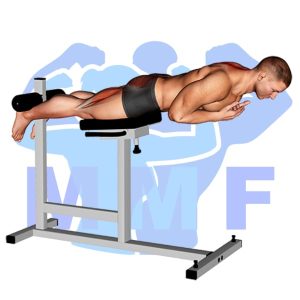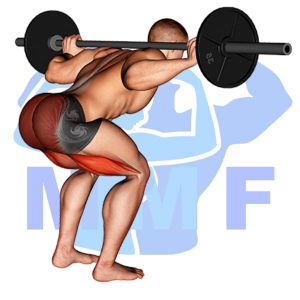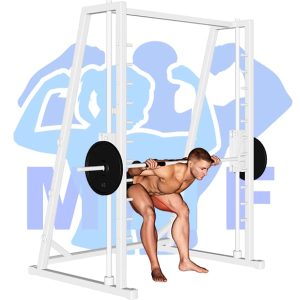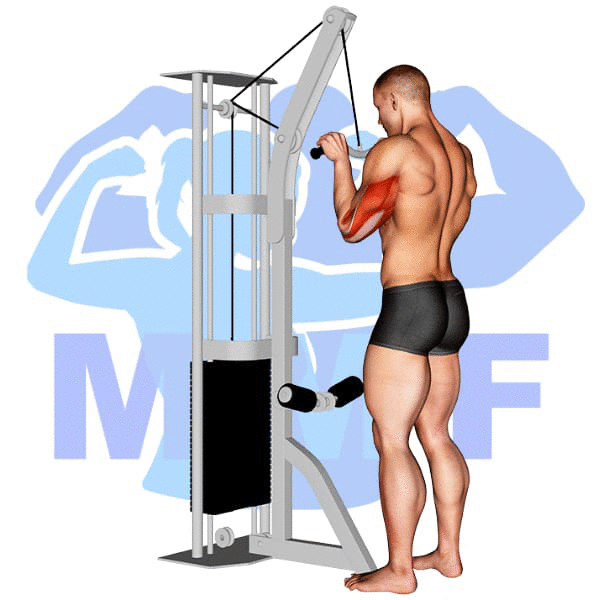Do you experience lower back pain after performing deadlifts or squats? The culprit could be a reverse hyperextension, a common movement in these exercises that can lead to discomfort and even injury if not executed correctly. Don’t worry, you’re not alone. Many fitness enthusiasts struggle with lower back pain caused by incorrect form in the gym. Fortunately, in this blog post, we will be diving into the proper technique for performing a reverse hyperextension and how to prevent lower back pain during your workouts. Say goodbye to discomfort and hello to a strong, pain-free back!
Reverse Hyperextension Summary
- Primary Muscles: Erector Spinae
- Secondary Muscles: Gluteus Maximus, and Hamstrings
- Equipment: Bench
- Mechanics Type: Compound
- Force: Pull
- Utility: Basic or Auxiliary

Reverse Hyperextension Instructions
- To perform this exercise on a bench, start by laying on the bench with your legs hanging off and grab the bench with your arms.
- With your legs straight, lower your feet, stop just before your feet hit the ground.
- Next, lift your legs back up, pulling with your posterior.
- Pause at the top and repeat for your desired number of reps.
Video Tutorial
Reverse Hyperextension Muscles
Target (Agonist)
Synergists
Dynamic Stabilizers
- None
Stabilizers
- Deltoid – Anterior
- Levator Scapulae
- Trapezius – Middle
- Trapezius – Upper
- Wrist Flexors
Antagonist Stabilizers

Benefits of Reverse Hyperextension
The Reverse Hyperextension exercise is a great way to target the Erector Spinae muscle, which is located along the spine. This exercise not only strengthens the Erector Spinae, but it also helps to improve overall posture and stability in the lower back. It is especially beneficial for those who suffer from lower back pain, as it helps to increase flexibility and range of motion in the lumbar area. Additionally, this exercise can help to improve balance, coordination and body control. As an added bonus, this exercise also helps to strengthen and tone the glutes and hamstrings.
Tips for Performing Reverse Hyperextension
You’ve come to the right place if you’re trying to advance your reverse hyperextension performance. Using these suggestions can allow you to maximize the advantages of this amazing workout. You’ll have the ability to develop your core muscles, and minimize your risk of getting hurt. Let’s get started and explore how these tips will benefit you.
- Use good form: Maintaining good form when doing a reverse hyperextension is essential to avoid injury and get the most out of your exercise. Keeping your core tight and maintaining a neutral spine will help you get the most out of the exercise and keep you safe.
- Engage your glutes: When performing a reverse hyperextension, make sure to really engage your glutes at the top of the movement to ensure that you are working the muscle group you are trying to target. This will also help to prevent injury.
- Control your tempo: Slowing down your tempo during a reverse hyperextension will help you really engage the muscles being worked and get the most out of your exercise. Taking your time and controlling your movements will help you get the most out of your bodyweight exercise.
Benefits and Tips Video
Frequent Mistakes To Avoid
When conducting reverse hyperextension, avoiding typical errors is usually the difference between an effective workout and a painful injury. Also, in order to maximize your benefits of the exercise, appropriate form is required. Through preventing these frequent errors, you will raise your performance and get the results you want. Don’t worry, though, it’s not at all difficult as it may appear. You can execute the exercise safely and effectively by understanding the errors to prevent and by executing the correct steps. So it is time for you to maximize your results from this exercise and experience the benefits of a productive workout.
- Not keeping their core engaged throughout the entire movement – This mistake can lead to lower back injury and reduce the effectiveness of the exercise.
- Not using a full range of motion – This mistake can cause an imbalance in strength, as only certain muscle groups are being worked and the full potential of the exercise is not being utilized.
- Not using proper form – This mistake can also lead to injury and reduce the effectiveness of the exercise. Proper form helps ensure that the exercise is being done correctly and efficiently.
Find More Bodyweight Exercises Here
Variations and Complementary Exercises
There are many variations, complementary, or alternative exercises that can be used in place of the Reverse Hyperextension exercise. These exercises work similar muscles as the Reverse Hyperextension and can be used to increase the intensity of your workout. Below are a few of these exercises:
Lever Reverse Hyperextension (Machine)

The Lever Reverse Hyperextension Machine is a great alternative or complementary exercise to the traditional Reverse Hyperextension. This machine allows users to modify the angle of the exercise so that they can target specific muscle groups, such as the hamstrings, glutes, and lower back. It also helps to increase flexibility and range of motion, which can be difficult to achieve with the traditional exercise. Additionally, the Lever Reverse Hyperextension Machine can provide extra stability and support for those who are unable to perform the exercise in its traditional form. Ultimately, it is an excellent choice for anyone looking to add variety to their exercise routine or improve their lower body strength.
45 Degree Hyperextensions

45 Degree Hyperextensions are a great complementary or alternative exercise for Reverse Hyperextensions. This exercise works the same muscles as Reverse Hyperextensions, but it puts less pressure on the lower back and helps to prevent any strain on the spine. Unlike Reverse Hyperextensions, 45 Degree Hyperextensions involve lifting your legs off the ground while lying on an inclined bench at a 45 degree angle. This exercise targets the glutes, hamstrings, and lower back, making it an effective way to strengthen and tone these areas. Additionally, it helps to improve core stability and balance, making it a great exercise for people of all fitness levels.
Hyperextension

Hyperextension is an exercise that helps to strengthen the lower back, and glutes. It is performed by lying face down on a hyperextension bench with the feet secured and the hips raised. The hips are then lowered and raised while keeping the torso in a straight line. This exercise is great for those looking to strengthen their lower back and glutes and is a great complementary or alternative exercise to Reverse Hyperextension. Reverse Hyperextension focuses on strengthening the posterior chain muscles of the hamstrings, glutes, and lower back. It is performed by lying face down on a reverse hyperextension machine with the hips raised and feet secured. While in this position, the hips are then lowered and raised while keeping the torso in a straight line. Both exercises are great for strengthening the lower back and posterior chain muscles, however, each exercise has its own unique benefits so it is important to incorporate both into your workout routine.
Check Out These Top Bodyweight Exercises
Barbell Stiff Leg Good Morning

The Barbell Stiff Leg Good Morning is a great alternative or complementary exercise for the Reverse Hyperextension. This exercise works the glutes, hamstrings, and lower back in a similar way as the Reverse Hyperextension, but it also provides extra stimulation to the erector spinae muscles. To perform the Barbell Stiff Leg Good Morning, stand with feet hip-width apart and hold a barbell behind your back. Keeping your back flat and knees slightly bent, bend at the hips and lower the barbell until your torso is parallel to the ground. Hold this position briefly before slowly returning to the starting position. This exercise is excellent for developing strength in the lower body, which can help improve performance in many sports and activities.
Barbell Good Morning

The Barbell Good Morning is a great complementary or alternative exercise to the Reverse Hyperextension. It works the same muscles as the Reverse Hyperextension, but in a slightly different way. In the Barbell Good Morning, you stand with your feet hip-width apart and hold a barbell across your back. You then bend your hips and lower your torso until it is parallel to the floor, and then return to standing. This exercise is great for strengthening the lower back and glutes, and improving flexibility and mobility.
Smith Machine Good Morning Off Pins

The Smith Machine Good Morning Off Pins is an effective and easy-to-use alternative exercise for the Reverse Hyperextension. It allows the user to load weight onto the barbell, which then rests on adjustable pins set to the desired height. This way, the user can work on their form and practice the exercise without having to worry about balancing the weight or the risk of injury. It also allows for a greater range of motion, which can help to target the glutes, hamstrings and lower back muscles more effectively. This exercise is particularly useful for those looking to increase their strength, stability and mobility in the posterior chain.
Find More Lower-Back Exercises Here
Opposing Complementary Exercises
To further develop your lower back and posterior chain, it’s important to include exercises that use the opposite muscle groups. This will help you to build a balanced and strong physique. Below is a list of exercises that complement the exercise Reverse Hyperextension by using opposing muscle groups.
Lever Decline Sit Up (Machine)

The Lever Decline Sit Up machine is an excellent complement to the Reverse Hyperextension exercise. While Reverse Hyperextension works the back muscles, the Lever Decline Sit Up machine works the abdominal muscles. This combination of exercises strengthens both the back and abdominal muscles and helps to balance out the body’s core strength. The Lever Decline Sit Up machine also helps to strengthen the hip flexors and obliques. This exercise works both the concentric and eccentric muscle contractions, which will help to further increase core strength.
Leg Raise Hip Lift Crunch

The Leg Raise Hip Lift Crunch is a great complement to the Reverse Hyperextension exercise. This exercise works the lower abdominal muscles and hip flexors, using the opposing muscle group to the Reverse Hyperextension. This allows for a full body workout, targeting both the upper and lower body, strengthening and toning the entire core. Not only does this exercise help to increase strength in the abdominal and hip flexor muscles, but it also increases overall stability and balance.
Leg Raise Crunch

The Leg Raise Crunch is a great complement to the Reverse Hyperextension. This exercise works your abdominal muscles while the Reverse Hyperextension works your lower back and glutes. The Leg Raise Crunch is performed by lying flat on your back, lifting your legs off the floor and crunching your upper body towards your legs. This exercise strengthens the rectus abdominis, obliques, and hip flexors. On the other hand, the Reverse Hyperextension targets the glutes and hamstrings. This combination of exercises helps to create balance and strength in opposing muscle groups which helps to improve overall core stability and strength.
Activate Your Posterior Chain with Reverse Hyperextensions
One of the keys to developing a strong, balanced physique is by focusing on your posterior chain, or the muscles in the back of your body. These muscles include the lower back, glutes, and hamstrings, and they play a crucial role in everything from posture to athletic performance. One exercise that can help you strengthen these muscles is the reverse hyperextension. This movement specifically targets the lower back and glutes, helping to improve spinal stability and hip function. Incorporating reverse hyperextensions into your workout routine can go a long way in helping you build a strong, healthy body from the inside out.
References: Wikipedia | ExRx.net | PubMed.gov | Comprehensive List of Lower-Back Bodyweight Exercises




